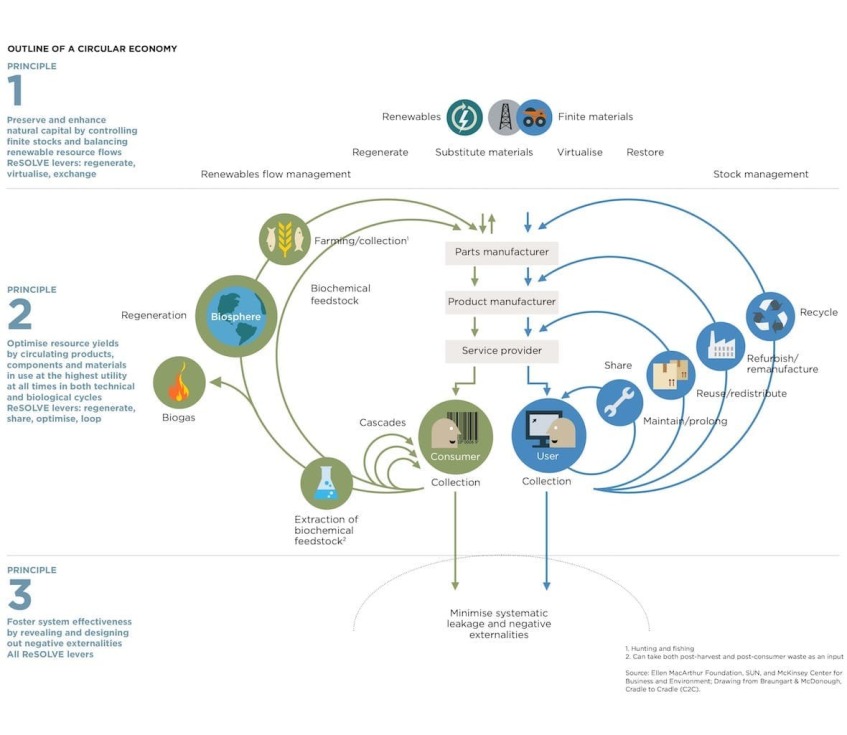Our way of life is unsustainable.
I don’t think most people would disagree with this. Our climate, the animals in our ecosystem, our mental and physical health are all suffering as a result. And there is no planet B. Drastic change is necessary. And, while it may start with courageous individuals igniting protest movements, it requires the engines of our economy to change: businesses. Enter: the circular economy.
A circular economy is an approach to business that aims to redefine what it means to grow. It leaves behind our “take-make-waste” extractive industrial model to shift towards regenerative, circular growth. As the Ellen MacArthur Foundation writes, the circular economy “entails gradually decoupling economic activity from the consumption of finite resources, and designing waste out of the system”.
The circular economy is based on three foundational principles:
- Design out waste and pollution
- Keep products and materials in use
- Regenerate natural systems
The below diagram by the Ellen MacArthur Foundation is quite a good summary of the principles put into action. 
I don’t want to use this space to talk your ear off (write your eyes off?) about the workings of a circular economy — people have done that much more successfully than I will here, here, and here. What I want to do, instead, is share two companies that have taken this principle to heart and applied rigorously to their businesses.
Winnow
Winnow is a British startup-aimed at reducing waste in commercial kitchens, which currently  amounts to 20% of food purchased. The company uses smart meters to analyze trash. This analysis is then used to identify waste reduction methods. Since its inception in 2013, the start-up has cut food waste in half in hundreds of kitchens worldwide. It has resulted in $29M+ and 39K tons of CO2 saved.
amounts to 20% of food purchased. The company uses smart meters to analyze trash. This analysis is then used to identify waste reduction methods. Since its inception in 2013, the start-up has cut food waste in half in hundreds of kitchens worldwide. It has resulted in $29M+ and 39K tons of CO2 saved.
What I find particularly impressive about this company, in addition to its sophisticated technology solution, is its dedication to educating the business community about circular business models. The founder, Marc Zornes, has been an outspoken advocate, speaking at venues and TED stages across the world. He is urging people like him to take the next step into a sustainable future.
AB InBev
AB InBev, one of the largest beer manufacturers in the world, is not some startup trying something whacky with no fear of failure. It is a public company with investors and a public image to maintain. Yet  it has proven to us that even a well-established corporation can take steps towards a circular business model. One of their recent inventions, Canvas Barley Milk, is a drink made from spent grains, the by-product resulting from brewing operations. In the past, AB InBev sold this waste to be used for animal feed. Since this waste cannot be stored, if there are no active farmers near an AB InBev brewing site, the waste is dumped. However, because of the rest grain’s protein-dense nutritional value, the company found another purpose for it. It turned waste into value. Currently, the drink is sold in select stores around the United States; the company has plans to expand in the coming years.
it has proven to us that even a well-established corporation can take steps towards a circular business model. One of their recent inventions, Canvas Barley Milk, is a drink made from spent grains, the by-product resulting from brewing operations. In the past, AB InBev sold this waste to be used for animal feed. Since this waste cannot be stored, if there are no active farmers near an AB InBev brewing site, the waste is dumped. However, because of the rest grain’s protein-dense nutritional value, the company found another purpose for it. It turned waste into value. Currently, the drink is sold in select stores around the United States; the company has plans to expand in the coming years.
There are many more examples of companies doing the hard work of transforming the way they do business to be more circular. One of my altMBA peers (a great program I am currently enrolled in, check it out) shared with us a tool called the Circular Board. It is a business model canvas reimagined for the circular economy. I urge you to download it here and go through the process of filling it out at the organization for which you work. No matter whether you are an entry-level or senior employee, it is your responsibility to talk to your team about this important transition I believe all companies must make in the near future.